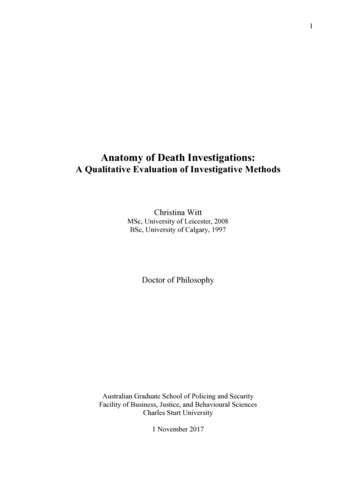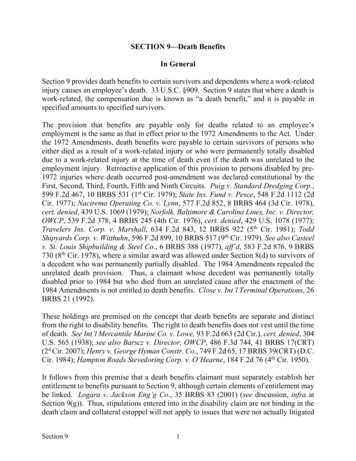
Transcription
1Anatomy of Death Investigations:A Qualitative Evaluation of Investigative MethodsChristina WittMSc, University of Leicester, 2008BSc, University of Calgary, 1997Doctor of PhilosophyAustralian Graduate School of Policing and SecurityFacility of Business, Justice, and Behavioural SciencesCharles Sturt University1 November 2017
2STATEMENT OF AUTHORSHIPThis dissertation is submitted as partial fulfilment of the requirements for the degree ofDoctor of Philosophy by research. I hereby declare that this submission is my own work andthat, to the best of my knowledge and belief, it contains no material previously published orwritten by another person nor material which to a substantial extent has been accepted for theaward of any other degree or diploma at Charles Sturt University or any other educationalinstitution, except where due acknowledgment is made in the dissertation. Any contributionmade to the research by colleagues with whom I have worked at Charles Sturt University orelsewhere during my candidature is fully acknowledged.I agree that this dissertation be accessible for the purpose of study and research inaccordance with the normal conditions established by the Executive Director, LibraryServices or nominee, for the care, loan and reproduction of theses.Christina Witt (née Van Hereweghe)
3ACKNOWLEDGEMENTSI would like to acknowledge the support I have received from Charles Stuart University,particularly my principal academic supervisor Dr Hank Prunckun. I will forever be gratefulfor your mentorship, commitment to my research and wise insight. Without Dr Prunckun’ssupport, I would never have been able to complete this thesis.I would like to extend my gratitude and thanks to friends and colleagues at Mount RoyalUniversity, whose support and encouragement were instrumental for me beginning thisjourney. Thank you Dr Kelly Sundberg and Dr Tanya Trussler for your friendship andguidance, and for the editing and review of this thesis. A huge thank-you to my editor, MsJana Lait, whose keen eye improved the quality of this thesis.To my work family at Calgary Police Service, specifically the members of theHomicide Unit and the subject matter experts who participated in this survey, I am gratefulfor your contributions and support. Thank-you Kim Assailly for taking the time to read thisthesis and providing insight and feedback. I have spent over half my life with this policeservice and am proud to be a sworn member with the Calgary Police Service. Thank-youCalgary Police Service for the research agreement for access to documentation and data, andfor tuition aid.Finally, to my family whose unwavering support I cherish and depend on. To mymother, Teresa Ridgen, you have been a pillar of strength my entire life. I honestly wouldnot be where I am today without your kindness and love. To my aunt, Jeannette Richter, youtoo have stood behind me my entire life journey, including reading this thesis and providinginsightful feedback. You are both strong women whom I love and admire.To my beautiful little girl, Sawyer, your innocence and wholehearted belief thatdreams come true if you work hard inspires me. I hope I can always model for you that nodream is too big if you put your heart and mind to it—you will succeed.
4ABSTRACTThis study explores effective processes and procedures of homicide investigation to achieveincreased homicide solution. Homicide investigations do not operate in isolation, thereforethe changing nature of law enforcement’s external environment such as crime trends,community support, technology, and the law, were central components to the analysis. Basedon contingency theory, police agencies must be agile and adaptable within their dynamicenvironments to be effective. The Delphi method was used to conduct the analysis bybuilding consensus on what constitutes an effective model for homicide investigations. Apanel of criminal justice subject matter experts were selected among internal and externalstakeholder groups to complete three survey rounds.The study explored consideration of clearance rate and conviction rate, proceduralsuccess, police legitimacy and credibility, examination into Calgary Police Service homicideprocesses and procedures such as the homicide unit mandate, overtime procedures, casereview, and the cold case unit. Three key concepts emerged for achieving effective homicideinvestigations: (a) the importance of a definition for the measurement of successful homicideinvestigations; (b) community support of the police agency; and (c) identification of effectiveorganisational methods of homicide investigations. Based on these findings, a model of bestpractices of homicide investigations was developed, combining overlapping aspects from thethree key concepts.This study contributes to the limited literature on homicide investigative processesand procedures based on consensus of what constitutes an effective method of homicideinvestigation to achieve increased homicide clearance without jeopardising the integrity ofthe investigation.
5CONTENTSSTATEMENT OF AUTHORSHIP. . 2ACKNOWLEDGMENTS . 3ABSTRACT . 4CONTENTS . 5GLOSSARY OF TERMS . . 7CHAPTER 1: INTRODUCTION . 8Background . . 8Rationale 10Contingency Theory . 11Research Question . 13Approach of the Study . 14Outline of the Study . 14CHAPTER 2: LITERATURE REVIEW . 17Homicide in Canada . 17Investigating Criminal Offences . 19Investigating Metrics and Homicide Clearance Rates 23Police Credibility and Legitimacy . . . 26Contingency Theory . 28External Impacts on Police Organisational Efficiency . 30Canadian Charter of Rights and Freedoms Impact on Police Operations& Investigative Procedures . 32Organisational Influences on Homicide Clearance and Police Efficiency.35Homicide Investigation Best Practices . 41CHAPTER 3: METHODOLOGY . 49Research Design . 49Data Collection . . 52Data Collection and Analysis . 58Limitations . 59CHAPTER 4: RESULTS . . 60
6Delphi Technique . . 60Survey Round I . . 60Survey Round II . 70Survey Round III . 83CHAPTER 5: DISCUSSION . 93Introduction . . 93Defining Effective Homicide Investigations . . 93Police Legitimacy and Credibility . 96Calgary Police Service Homicide Processes and Procedures . 98Conclusion . . 113REFERENCES . 116APPENDIX . . 125Appendix A: Participant Information Sheet . . 125Appendix B: Participant Consent Form . . 128Appendix C: Survey I . . . 129Appendix D: Survey II . 137Appendix E: Calgary Police Service Homicide Process Map . 151Appendix F: Survey III . 152
7GLOSSARY OF TERMSThe following terms were obtained from Statistics Canada (n.d.) Canadian Centre for JusticeStatistics (CCJS) Scoring Guide:HomicideA homicide occurs when a person directly or indirectly, by any means, causes the death of ahuman being. Homicide is either culpable (murder, manslaughter or infanticide) or nonculpable (not an offence). Deaths caused by criminal negligence, suicide and accidental orjustifiable homicide (i.e. self-defence) are not included (Statistics Canada, n.d., p. 13).Homicide RateThis technique standardizes data to permit comparisons between different geographic regionsfor different years and for different population sizes. The homicide rate is based on thenumber of victims per 100,000 populations (Statistics Canada, n.d., p. 13).Solved HomicideA solved homicide is one that police have cleared either by laying or recommending ahomicide charge or cleared by other means (e.g., suicide of the accused). This term refers onlyto police investigation and not to court disposition (i.e., a homicide can be “solved” even if anaccused person has not been convicted) (Statistics Canada, n.d., p. 14).Homicide Cleared OtherwiseCan include police discretion, child (under age of 12), mental illness, witness incapacity,death, immunity, extradition, witness refusal, diversion (alternative justice forum), YouthCriminal Justice Act (YCJA) referral (person 12-17 years). Crown’s deciding not toprosecute does not count (Statistics Canada, n.d., p. 38).Homicide Not ClearedIncludes all homicide incidents that have not been cleared (no accused has been identified).For such un-cleared homicides, the police may have strong suspicions against a particularperson; however, an Accused Questionnaire is not to be submitted until the accused has beencleared by charge, suicide, or otherwise (Statistics Canada, n.d., p. 38).PolicyPolicies are the overall guiding principles, which govern the implementation of anorganisation’s processes (Boutros & Purdie, 2014, p. 24).ProcessThe processes are the related activities performed to achieve a specific result, using inputssuch as people, systems and tools to transform them into desired outputs (Boutros & Purdie,2014, pp. 22-26).ProcedureProcedures are the detailed steps necessary to carry out the processes (Boutros & Purdie,2014, p. 26).
8CHAPTER 1 — INTRODUCTIONBACKGROUNDHomicide characteristically is a central topic of interest for both the media and public, and thesolving of homicides is of the highest priority for law enforcement agencies, and integralwithin the criminal justice system. While in 2014, police agencies in Canada reported thelowest homicide occurrences (1.45 per 100,000 populations) since 1966, homicide clearancerates in both Canada and the United States (U.S.) have been on the decline (Miladinovic &Mulligan, 2015, p. 3; Silverman & Kennedy, 1997, p. 81; Regoeczi, Kennedy & Silverman,2000, p. 135).Homicide investigations are often complicated and considered one of the mostchallenging types of investigations for police, typically encompassing all components of acriminal investigation (Osterburg & Ward, 2014, p. 371). These investigations require thecollection of three types of information: witnesses, physical evidence, and documentation(Osterburg & Ward, 2014, p. 445). A police agency’s ability to solve homicides is directlyimpacted by the organisational methods used to collect these sources of information (Cronin,Murphy, Spahr, Toliver, & Weger, 2007, p. 2). Homicide investigations have becomeprolonged and highly complex due to a variety of factors such as technological advancements,the changing nature of homicides—such as increased drug activity and firearms use—andgreater public apathy, resulting in alternate investigative practices (Innes & Brookman, 2013,p. 287; Halloran, n. d., p. 134; Cronin et al., 2007, p. 13). Societal demands and revisions tolegal procedures have also impacted the processes of homicide investigations (Osterberg &Ward, 2014, p. 265). According to Innes and Brookman (2013), modifications of theprocesses, procedures, and protocols of homicide units are required to improve the integrity,effectiveness, and professionalism of major crime investigation (p. 287).Over the last few decades the United Kingdom’s (U.K.) Association of Chief PoliceOfficers Homicide Working Group has developed best practices for homicide investigationsthrough publications by the National Policing Improvement Agency, including: (a) CoreInvestigative Doctrine; (b) the Murder Manual; and (c) the Major Incident Room StandardAdministrative Procedures (Kirby, 2013, p. 97). The purpose of these documents was toprovide procedural guidance for police conducting homicide investigations (Innes &Brookman, 2013, p. 287). Similarly, in the U.S., researchers such as Cronin et al. (2007),Keel, Jarvis and Muirhead (2009), and Carter and Carter (2016) have addressed issuessurrounding best practices when investigating homicides. In Canada, the Royal CanadianMounted Police have developed an internal Major Case Management document aimed atidentifying best practices when investigating serious criminal incidents, and in Australia,Westera, Kebbell, Milne, and Green (2014) have examined the key characteristics of aneffective detective. As Innes (2002) acknowledges, over the years there have been noted
9developments focused on advancing criminal investigative practices, however there remainslimited academic examination into the process of investigation and the factors that affectthese investigations (Innes, 2002, p. 669). According to Innes (2002):Notions of ‘process structure’ aim to capture the sense on which police investigationsare oriented around an ordered sequence of actions. This results from the way in whichthe police organization enacts its environment and introduces procedures, routines andconventions, as part of an ‘investigative methodology,’ to facilitate the direction andcoordination of social action with the intention of realising its objectives. As a result,individual investigators can be seen to share similar dynamics and trajectories in termsof how they are enacted by detectives (p. 672).In 1975, the RAND Corporation released a report consisting of three volumes, The CriminalInvestigation Process; (a) Volume I: Summary and Policy Implications by Greenwood andPetersilia; (b) Volume II: Survey of Municipal and County Police Departments by Chaiken;and (c) Volume III: Observations and Analysis by Greenwood, Chaiken, Petersilia andPrusoff. Collectively these volumes have been referred to as the RAND report. These reportscontributed to the limited research on investigative methods. Arguably, there has been verylittle research specific to the advancement of detective work, let alone the methods used bydetectives since the RAND report (Liederbach, Fritsch, & Womack, 2011, p. 50). AsLiederbach et al. (2011) have identified, the concepts of detective work has basicallyremained the same for the past 30 years, suggesting a great need for more studies focused onhow major crime investigations can improve within today’s rapidly changing criminal justiceenvironment (p. 50).Understanding the distinction between policy, processes and procedures is importantwhen considering process improvements of homicide investigations (Boutros & Purdie, 2014,p. 24). Policy is typically focused on the guiding principles that govern the implementationof an organisation’s processes; yet provide minimal benefit in relation to the wayinvestigators improve and advance (Boutros & Purdie, 2014, p. 24). The processes are therelated activities performed to achieve a specific result, using inputs such as people, systems,and tools to transform them into desired outputs (Boutros & Purdie, 2014, pp. 22–26).Procedures are the detailed steps necessary to carry out the processes (Boutros & Purdie,2014, p. 26). As discussed in this thesis and as highlighted by noted scholars like Liederbachet al. (2011), a key means for increasing the rate of homicide clearance—and increasingclearance rates for other major crimes—is more research focused on identifying innovative,profession-informed, and evidence-based ways to advance investigative techniques andimproved workload management (p. 50).Cronin et al. (2007) composed one of the benchmark publications influencing thisstudy. As Cronin et al. (2007) suggest, a number of key questions homicide managers shouldconsider, include: (a) how do their community stakeholders define “effectiveness;” (b) haveinvestigators been provided all available resources needed to increase the likelihood of
10successful arrest, charge, and conviction; and (c) are investigators receiving adequate trainingand education to function effectively (p. 34).RATIONALETraditional investigative techniques, many spanning 30 years since the RAND report continueto achieve the desired results sought by most homicide investigators, however, new insightabout the application of these techniques undoubtedly would improve effectiveness andapplicability (Carter & Carter, 2016, p. 151). Likewise, further research into the investigativeactions of homicide detectives also would improve investigative effectiveness by promotingbroader understanding of how their techniques impact homicide clearance (Puckett &Lundman, 2003, p. 188).The subject literature pertaining to U.S. police management systems highlight a numberof the best practices for homicide investigations, such as: (a) the number of detectivesassigned at the onset of the investigation; (b) quick response by the investigators arriving atthe crime scene; and (c) the use of investigative tools such as computer information systemsthroughout the investigative process (Keel, 2012, p. 27; Wellford & Cronin, 2000, p. 3).Consideration should be given to the number of personnel required to meet the investigativeneeds of a homicide unit (McDevitt, 2005, pp. 23–27). The level of cooperation within ahomicide unit and between agencies, investigator characteristics, plan of investigation andmethodology to execute it, and a system in place to record the data are important factorsrequiring examination when determining best practices (Castleman, 2000, pp. 6–8).Researchers in other countries have examined police perspectives on homicideclearance and investigation. U.K. researchers Brookman and Innes (2013) examined theattributes that define success for police organisations (p. 293). Australian researchersMouzos and Muller (2001) compared solved and unsolved homicides to determine whichfactors differentiate between the two and incorporated the perspectives of homicideinvestigators into the analysis.There is limited research into the field of homicide clearance and homicideinvestigative processes and procedures, with the exception of the U.S. studies by Wellford,Cronin, Brandl, Bynum, Eversen and Galeria (1999), Keel, Jarvis and Muirhead (2009), andKeel (2012), which utilised case data and survey protocols to identify best practices forhomicide investigations. Additionally, the U.K. study by Brookman and Innes (2013)examined police organisations’ perceptions of success in relation to homicide investigationsby surveying police agencies, as did the Australian study by Mouzos and Muller (2001) whoconducted a comparison of solved versus unsolved homicides and incorporated homicidedetective perspectives in the study.Particularly in Canada, there is a scarcity of research in the field of homicide clearance(Trussler, 2011, p. 2), and no Canadian research was discovered pertaining to processes andprocedure evaluation of homicide investigations. Carter and Carter (2016) stated, “new
11techniques and a new organisational philosophy of homicide investigations may help increasethe effectiveness of these inquiries ” however, “ despite this generally held belief, littlescholarly attention has been paid to the actual work the police do to clear homicide cases ”(p. 151). Carter and Carter (2016) identified a deficiency in knowledge about the impact ofpolice investigative processes on homicide clearance (p. 153).This study bridged the gap between the research from other countries and itsapplication in Canada. The evaluation of Calgary Police Service’s homicide processes andprocedures adds insight into homicide investigations that are specific to Canada—an area ofresearch that has not been studied before. In this regard, this study contributes to knowledgefrom a scholarly perspective, as well as a practical perspective—that is, it can inform CalgaryPolice Service managers and leadership executive about improvements in effective homicidemethods.CONTINGENCY THEORYHogwood and Gunn (1984) describe evaluation studies as an examination process of certainpolicies to determine if their outcomes have achieved the policy objectives (p. 27). In thisstudy, homicide clearance was categorised as the organisational output and the integrity orquality of the investigation as the outcome.According to Donaldson (1995) and Maguire (2003), contingency theory states that anorganisation is required to stay current and adapt to its constantly changing environment to beeffective (as cited in Maguire, King, Johnson, & Katz, 2010, p. 375). For criminal justiceorganisations to achieve effective crime prevention, managers must use evidence to guide thecreation of policy and continued policy developments (Ministry of Justice, 2012, p. 8).The environment of law enforcement agencies consists of external factors that affectthe ability of agencies to solve cases such as homicide case factors, information and rawmaterials. The adequacy of an organisation’s policies and procedures (its technologies) arethe internal factors (Hasenfeld, 1992, Maguire, 2003, as cited by Maguire et al., 2010, p. 375).Donaldson (1995) and Maguire (2003) as cited in Maguire et al. (2010) relate contingencytheory to a homicide unit as follows:All organizations—whether public or private, profit or non-profit, manufacturing orservice—take some raw material or input, process it using some technologies (whichmay be material, electronic or social), and transform it into some output. Viewed inorganisational terms, the raw material or input in a homicide bureau is an unsolvedmurder case. The clearance itself represents the ultimate output. The technologyconsists of all the internal processes used by the organization to transform inputs intooutputs, or put another way, to transform unsolved cases into solved cases. All ofthe factors external to the organization that influence its ability to solve cases are apart of the organization’s environment. The essential challenge for any organizationis to adapt its technologies to its environment. This is one of the basic premises of
12Contingency theory, which posits that effective organizations must maintain a properfit with their environment (p. 374).Contingency theory emphasises that an organisation requires the ability to adapt to itsdynamic environment as a means to sustain effectiveness. Subsequently, the capacity formodification requires an effective method of detecting change and the ability and willingnessto implement necessary transformations (Maguire et al., 2010, p. 276). In this sense, adaptivecapacity is affected by the demands of the market and the ability of an organisation to changeto survive in that market; however, regardless of performance levels, police agencies andmany other public organisations are unlikely to go “out of business” (Maguire et al., 2010, p.376). As a result, the pressure to adapt is far less compared to other types of organisations(Maguire et al., 2010, p. 376).According to contingency theory, a police organisation’s homicide clearance rate isimpacted by external factors such as nature of the homicide, resources, and support (Maguireet al., 2010, p. 375). External changes are difficult for police agencies to manipulate(Maguire et al., 2010, pp. 396–397), and perceive. To address issues such as the decline inhomicide clearance, criminal justice agencies require the internal capacity through “ legalstructures and processes ” to be capable of detecting changes in the external criminalenvironment. Ultimately, it is important for police agencies to react suitably to thesefluctuations to maintain fit with the external criminal environment (Maguire et al., 2010, pp.396–397). The processes of a homicide unit guide what the investigators and managers do,while the procedures describe in detail how each activity within a process will be executed(Boutros & Purdie, 2014, p. 26). Procedures are used by organisations to ensure consistency,reduce errors and assist with training employees (Boutros & Purdie, 2014, p. 28).Homicide cases and the external criminal environment have changed immensely overthe past thirty years, causing new challenges for present day homicide investigators inrelation to: (1) the investigation and arrest of homicide offenders; and (2) the criminal trialand court procedures (Halloran, n.d., p. 141). Halloran (n.d.) describes some of the obstacleshomicide investigators face today in relation to the investigation and arrest of homicideoffenders, including staying apprised of changing legal requirements regarding the rights ofthe accused (pp. 141–142).Court’s rulings directly influence the manner in which homicide investigations areconducted, causing investigators to operate with an awareness that any action they takethroughout the course of an investigation may result in lengthy legal arguments during trial(Halloran, n.d., pp. 141–142). Holloran (n.d.) acknowledges that the media is a useful toolfor investigators but cautions that they can also create challenges and negatively impact ahomicide investigation (pp. 141–142). Homicide investigators should consider having astrategic media plan to manage the messages released to the public to protect the integrity ofthe investigation. Halloran (n.d.) recommends investigators continue to educate themselveson the advances in technology to understand the practical application of the information, and
13to maintain an on-going commitment to witness management due to the growing apathyamong citizens to get involved with police matters (Halloran, n.d., pp. 141–142).There is a paucity of research studying forensic evidence’s role in homicide investigationsand prosecution (McEwen, & Regoeczi, 2015, p. 1188). Forensic evidence includes, “ DNA evidence (i.e. evidence such as blood, saliva, or semen from which a DNA profile canbe obtained), latent prints, firearms, ballistics (shell casings, spent projectiles, etc.), drugs,clothing, trace, and others” (McEwen & Regoeczi, 2015, p. 1188). Researchers Hickman,Strom, and Johnson (2013) acknowledge the increasing demand for forensic evidenceparticularly by criminal justice professionals and popular culture, and suggest, “ a moreinformed understanding of how forensic evidence and other forms of evidence shape justiceoutcomes could result in a more efficient use of resources ” (p. S78 and S89).Halloran (n.d.) describes the issues faced by investigators related to criminal trials,including: (1) most offenders charged with murder do not plead guilty, resulting in long andprocedurally complex trials; (2) the duration of these trials often having voir dires which inessence results in a trial within a trial; and (3) the side effects of prolonged murder trials oftentying up homicide detectives for weeks due to them having to manage witnesses and alsoprepare their own testimony (Halloran, n.d., p. 142). In Canada, new case law (R. v. Jordan,2016, para. 5) clearly outlines that any delays beyond 30 months from the date of charge tothe actual or anticipated end of trial is presumed unreasonable. As a result, investigatorsmust have disclosure prepared before laying a homicide charge, and provide it to the crownprosecutor quickly for the prosecution to prepare their case in a timely manner for trial.Additionally, in Canada, there often is a preliminary hearing—sometimes a voir dire prior tothe actual murder trial, which can result in the criminal court process spanning several years.All of these changes have created challenges for homicide investigators to clear homicides.Today, more than ever before, it is evident that police organisations need to stay abreast ofthe rapidly changing crime and justice environment if they hope to remain effective inrealising investigative success in relation to homicide investigations, as well as with othermajor crime investigations.A summative evaluation of current Calgary Police Service homicide processes andprocedures, in conjunction with contributions from field experts, will assist this policeorganisation’s ability to make informed decisions regarding police investigative processessuitable to its shifting environment.RESEARCH QUESTIONHomicide investigations are often complicated and arguably one of the most important typesof criminal investigation (Eliopulos, 2003, p. 157) in that a jurisdiction’s homicide clearancerate can be considered a measure of its law enforcement agency’s effectiveness (Pare, Felson,& Ouimet, 2007, p. 244). Additionally, homicide resolution instils public trust in the stateand acts as a general deterrent (Wellford et al., 1999, p. 5).
14Carter and Carter (2016) identified two sets of factors influencing police effectivenessto clear homicides: (a) physical evidence; and (b) witness cooperation and communitysupport (p. 153). There is strong support in the subject literature that a community’s belief inthe legitimacy of their police agency will positively impact the likelihood for compliancewith police directives and the law (Telep & Weisburd, 2012, pp. 341–342). In theory, themore the community views the police as legitimate, the more likely the public is to exhibitcompliant behaviour, resulting in a reduction of crime (Telep & Weisburd, 2012, p. 342).It therefore follows that increased witness cooperation and community support areimportant for homicide solution. Effective homicide investigations based on sound processesand procedures are likely to increase homicide clearance, subsequently influencing citizens’view of police legitimacy. More effective investigative processes and procedures contributeto increased homicide solution, positively impacting community cooperation and support.There exists some research outlining best practices for homicide investigations(Brookman & Innes, 2013, p. 299). However, there is a paucity of research to determine ifthe methods suggested are being realised in practice. Therefore, using the jurisdiction of thecity of Calgary, in Alb
This study explores effective processes and procedures of homicide investigation to achieve increased homicide solution. Homicide investigations do not operate in isolation, therefore the changing nature of law enforcement's external environment such as crime trends, community support, technology, and the law, were central components to the .










